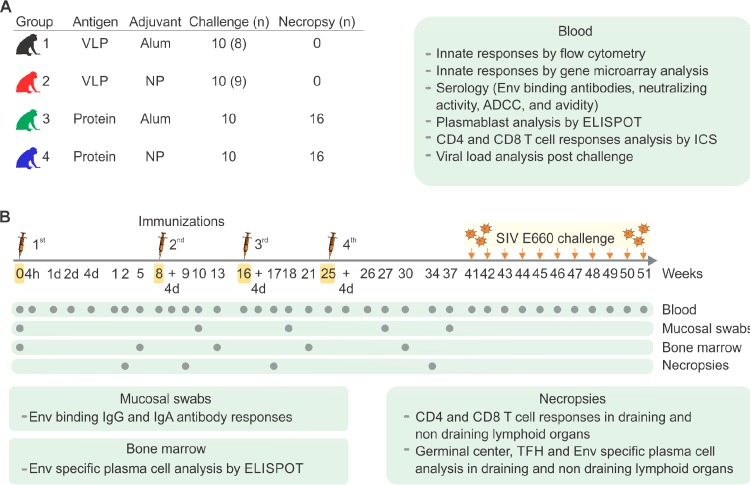Adjuvanting a Simian Immunodeficiency Virus Vaccine with Toll-Like Receptor Ligands Encapsulated in Nanoparticles Induces Persistent Antibody Responses and Enhanced Protection in TRIM5α Restrictive Macaques.
Our previous work has shown that antigens adjuvanted with ligands specific for Toll-like receptor 4 (TLR4) and TLR7/8 encapsulated in poly(lactic-co-glycolic) acid (PLGA)-based nanoparticles (NPs) induce robust and durable immune responses in mice and macaques. We investigated the efficacy of these NP adjuvants in inducing protective immunity against simian immunodeficiency virus (SIV). Rhesus macaques (RMs) were immunized with NPs containing TLR4 and TLR7/8 agonists mixed with soluble recombinant SIVmac239-derived envelope (Env) gp140 and Gag p55 (protein) or with virus-like particles (VLPs) containing SIVmac239 Env and Gag. NP-adjuvanted vaccines induced robust innate responses, antigen-specific antibody responses of a greater magnitude and persistence, and enhanced plasmablast responses compared to those achieved with alum-adjuvanted vaccines. NP-adjuvanted vaccines induced antigen-specific, long-lived plasma cells (LLPCs), which persisted in the bone marrow for several months after vaccination. NP-adjuvanted vaccines induced immune responses that were associated with enhanced protection against repeated low-dose, intravaginal challenges with heterologous SIVsmE660 in animals that carried TRIM5α restrictive alleles. The protection induced by immunization with protein-NP correlated with the prechallenge titers of Env-specific IgG antibodies in serum and vaginal secretions. However, no such correlate was apparent for immunization with VLP-NP or alum as the adjuvant. Transcriptional profiling of peripheral blood mononuclear cells isolated within the first few hours to days after primary vaccination revealed that NP-adjuvanted vaccines induced a molecular signature similar to that induced by the live attenuated yellow fever viral vaccine. This systems approach identified early blood transcriptional signatures that correlate with Env-specific antibody responses in vaginal secretions and protection against infection. These results demonstrate the adjuvanticity of the NP adjuvant in inducing persistent and protective antibody responses against SIV in RMs with implications for the design of vaccines against human immunodeficiency virus (HIV). The results of the RV144 HIV vaccine trial, which demonstrated a rapid waning of protective immunity with time, have underscored the need to develop strategies to enhance the durability of protective immune responses. Our recent work in mice has highlighted the capacity of nanoparticle-encapsulated TLR ligands (NP) to induce potent and durable antibody responses that last a lifetime in mice. In the present study, we evaluated the ability of these NP adjuvants to promote robust and durable protective immune responses against SIV in nonhuman primates. Our results demonstrate that immunization of rhesus macaques with NP adjuvants mixed with soluble SIV Env or a virus-like particle form of Env (VLP) induces potent and durable Env-specific antibody responses in the serum and in vaginal secretions. These responses were superior to those induced by alum adjuvant, and they resulted in enhanced protection against a low-dose intravaginal challenge with a heterologous strain of SIV in animals with TRIM5a restrictive alleles. These results highlight the potential for such NP TLR L adjuvants in promoting robust and durable antibody responses against HIV in the next generation of HIV immunogens currently being developed.
Authors
Sudhir Pai Kasturi; Pamela A Kozlowski; Helder I Nakaya; Matheus C Burger; Pedro Russo; Mathew Pham; Yevgeniy Kovalenkov; Eduardo L V Silveira; Colin Havenar-Daughton; Samantha L Burton; Katie M Kilgore; Mathew J Johnson; Rafiq Nabi; Traci Legere; Zarpheen Jinnah Sher; Xuemin Chen; Rama R Amara; Eric Hunter; Steven E Bosinger; Paul Spearman; Shane Crotty; Francois Villinger; Cynthia A Derdeyn; Jens Wrammert; Bali Pulendran
External link
Publication Year
Publication Journal
Associeted Project
Systems Vaccinology
Lista de serviços
-
StructRNAfinder: an automated pipeline and web server for RNA families prediction.StructRNAfinder: an automated pipeline and web server for RNA families prediction.
-
CEMiTool: a Bioconductor package for performing comprehensive modular co-expression analyses.CEMiTool: a Bioconductor package for performing comprehensive modular co-expression analyses.
-
webCEMiTool: Co-expression Modular Analysis Made Easy.webCEMiTool: Co-expression Modular Analysis Made Easy.
-
Assessing the Impact of Sample Heterogeneity on Transcriptome Analysis of Human Diseases Using MDP Webtool.Assessing the Impact of Sample Heterogeneity on Transcriptome Analysis of Human Diseases Using MDP Webtool.
-
Predicting RNA Families in Nucleotide Sequences Using StructRNAfinder.Predicting RNA Families in Nucleotide Sequences Using StructRNAfinder.
-
OUTBREAK: a user-friendly georeferencing online tool for disease surveillance.OUTBREAK: a user-friendly georeferencing online tool for disease surveillance.
-
Noninvasive prenatal paternity determination using microhaplotypes: a pilot study.Noninvasive prenatal paternity determination using microhaplotypes: a pilot study.
-
Editorial: User-Friendly Tools Applied to Genetics or Systems Biology.Editorial: User-Friendly Tools Applied to Genetics or Systems Biology.
-
Automatic detection of the parasite Trypanosoma cruzi in blood smears using a machine learning approach applied to mobile phone imagesAutomatic detection of the parasite Trypanosoma cruzi in blood smears using a machine learning approach applied to mobile phone images
-
Tucuxi-BLAST: Enabling fast and accurate record linkage of large-scale health-related administrative databases through a DNA-encoded approachTucuxi-BLAST: Enabling fast and accurate record linkage of large-scale health-related administrative databases through a DNA-encoded approach
-
Ten quick tips for harnessing the power of ChatGPT in computational biologyTen quick tips for harnessing the power of ChatGPT in computational biology

